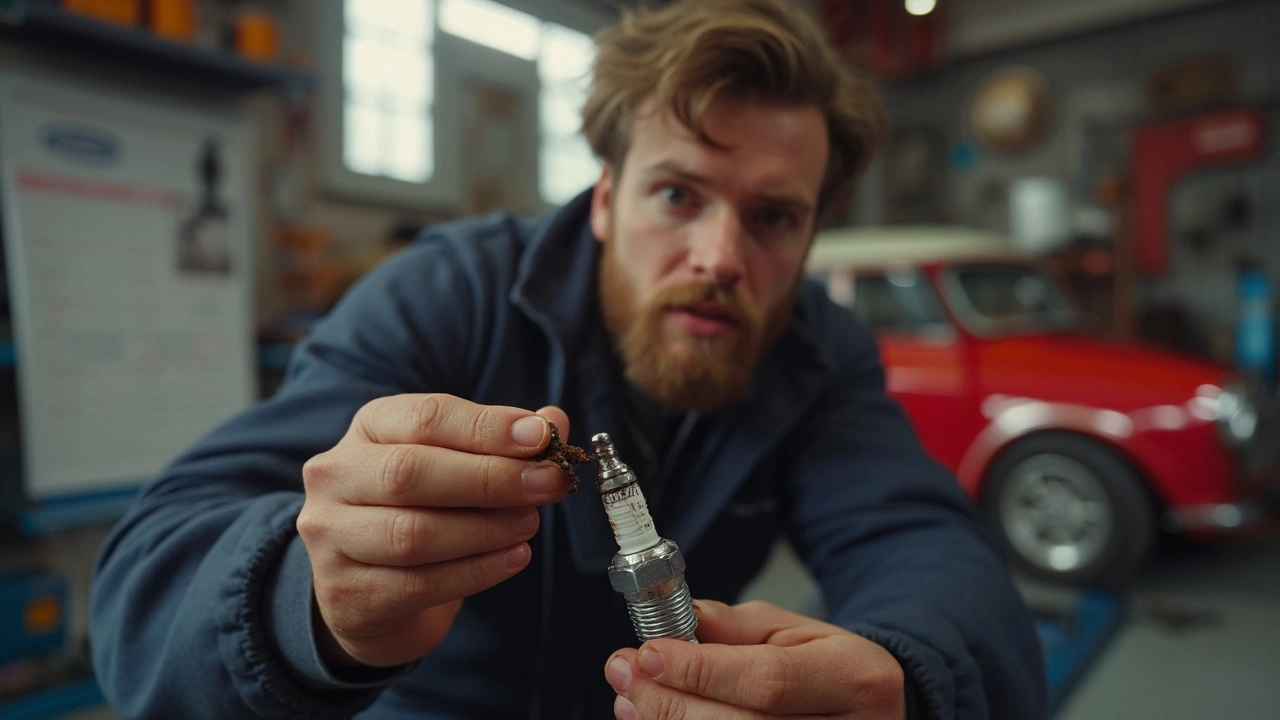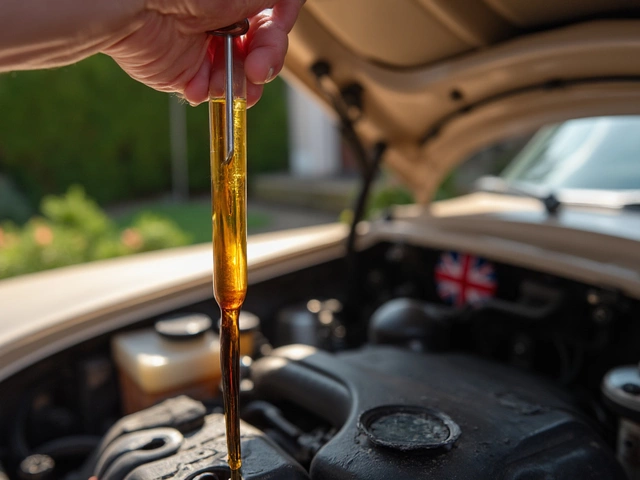Ever been late for work because your car just didn’t want to start? Or noticed your engine sounds like it's part of a lawnmower race? You could be dealing with a bad spark plug. This little part does a huge job—if it goes bad, your engine can turn moody fast.
Here’s the deal: Spark plugs ignite the mix of fuel and air in your engine. When they’re healthy, everything runs smooth. When they’re shot, you’ll feel it almost right away. Maybe your car shudders when stopped at a light, or you hear a weird popping sound from under the hood. Don’t just turn up the radio and hope it disappears. Small problems with your spark plugs can turn into expensive fixes.
If your check engine light flashes or your car drinks more gas than usual, don’t ignore it. These could be your spark plugs asking for attention. Even Max, my dog, perks up when he hears an oddly rumbling engine—and trust me, he usually only cares about treat bags. Let’s get into the most common symptoms, so you can catch the problem early and keep your ride running smooth.
- Rough Engine Idle: The First Warning Sign
- Hard Starting: More Than Just Bad Luck
- Engine Misfires: When Power Disappears
- Poor Acceleration: The Car Feels Sluggish
- Bad Fuel Economy: Money Down the Drain
- Diagnosing and Fixing Spark Plug Issues
Rough Engine Idle: The First Warning Sign
If your car shakes when you’re stopped at a light, or the engine sounds choppy instead of steady, that's a rough idle. Basically, your engine isn’t running as smoothly as it should when you’re not moving. This isn’t just annoying—it’s often the first sign there’s trouble with your spark plug symptoms.
What’s actually happening? A bad spark plug can cause uneven firing. That means one cylinder might miss a beat, making your engine vibrate or feel like it’s sputtering. Mechanics see this all the time: a worn or fouled spark plug can throw off the whole engine rhythm. It doesn’t take long before you notice more than just rough idling, but this is where things usually start.
Some cars even have a dashboard light for this. If your check engine light is flashing while you’re idling, that’s the car’s way of begging you to check the spark plugs first. Modern engines track misfire codes, and a scanner tool can help pinpoint if one plug is out of whack.
Here’s what drivers have noticed the most about rough idle when the spark plug is the problem:
- Steering wheel or whole car shakes slightly at stoplights
- Rumbling or popping noise from the engine bay
- Idle RPMs (the needle on your tach) jump up and down
- Engine seems like it’s about to stall, especially when the AC is on
Just to give you an idea of how common this is, check out this table with typical symptoms and what percentage of drivers report them when spark plugs go bad:
| Symptom at Idle | Reported by Drivers (%) |
|---|---|
| Shaking/rough vibrations | 61 |
| Uneven engine noise | 54 |
| Fluctuating idle RPM | 47 |
| Almost stalling at stops | 34 |
If you notice any of these signs, don’t just brush it off or crank up the tunes. Rough idle may seem harmless, but it usually means there’s a problem inside your engine you can’t see—yet. Checking or replacing spark plugs might be all it takes to get your smooth ride back.
Hard Starting: More Than Just Bad Luck
If you find yourself cranking and cranking, only to have your engine finally cough to life, you’re not just having a rough morning—your spark plug could be to blame. Think about it: the spark plug is what gives your engine the kick to actually get going. When it’s worn out, fouled, or covered in gunk, that spark is weak or missing altogether.
Cold weather can make it even tougher, but if your car is slow to start no matter the temperature, you need to check those plugs. According to car care surveys, around 30% of cars that don’t start reliably have issues with their ignition system, with bad spark plugs being the top culprit.
Let’s break down what can cause a bad spark plug to mess with your morning:
- The metal tip wears out over time, making it hard for a strong spark to form.
- Deposits from oil, fuel, or dirt build up on the plug, blocking the spark.
- The gap—the tiny space where the spark jumps—gets too wide or too narrow.
Here’s a quick comparison of healthy vs. failing spark plug stats:
| Condition | Engine Crank Time (sec) | Cold Weather Impact |
|---|---|---|
| Healthy Spark Plug | 1–3 seconds | Rarely affected |
| Failing Spark Plug | 5–10+ seconds | Worse; often won't start at all |
If your car struggles every time you turn the key, don’t blame the battery right away. Pop the hood and check your spark plugs. Even if you're not a pro mechanic, you can spot dirty or corroded tips. Changing them might be all it takes to get smooth starts again. And don’t assume new cars are off the hook—modern engines rely on perfectly working plugs just as much as the old beaters do.
Engine Misfires: When Power Disappears
Ever hit the gas and your car jerks or stumbles instead of taking off? That’s usually an engine misfire—one of the clearest signs you’ve got a bad spark plug. A misfire basically means that one or more cylinders didn’t get to do their job, so your engine skips a beat. It feels rough, especially when you’re accelerating or driving uphill. Sometimes, you’ll even hear a pop or a snap from the engine bay. That’s your car crying out for help.
What actually happens? In a four-cylinder car, even one dead spark plug can mess with a quarter of your engine’s power. That’s a huge drop you’ll notice right away. The most common causes for misfires are worn-out plugs, gunked-up electrodes, or cracked insulation. If the spark doesn’t happen when it should, the fuel doesn’t ignite, and boom—your engine stutters.
Keep your eyes out for these signs of misfire tied to spark plugs:
- Jerky engine movement, especially when idling
- Sudden loss of power when hitting the throttle
- Engine sounds “off”—like a sputter or uneven popping
- Check engine light flickers or blinks
How common are misfires related to bad spark plugs? According to a AAA 2024 study, about 60% of misfires in vehicles under 100,000 miles are caused directly by spark plug problems. That’s way more common than you might think, especially if you’ve skipped your last tune-up.
| Cause | Percentage of Cases (AAA 2024) |
|---|---|
| Worn Spark Plugs | 60% |
| Ignition Coil Failure | 23% |
| Fuel Injector Troubles | 10% |
| Other | 7% |
If you’re feeling any of these symptoms, don’t just hope they’ll go away. Misfires can kill your gas mileage and, over time, really mess with your engine (think: melted catalytic converter). Best move? Check your spark plugs, especially if you can’t remember the last time they were changed. It’s not a hard fix, but it’s one that can save you a fat repair bill if you act early.

Poor Acceleration: The Car Feels Sluggish
Ever stepped on the gas and wondered why your car just won’t pick up and go? That lag you feel isn’t just in your head. Poor acceleration is a classic sign you might have a bad spark plug. Spark plugs fire off quick sparks that help your engine push out power. If even one spark plug is on its last legs, your engine might hesitate or fall flat when you press the pedal.
This issue is usually more noticeable when you’re merging onto the highway or trying to pass another car. Instead of a quick response, you get a slow crawl. That’s not only frustrating, but it can also be risky in fast traffic.
So, what’s going on in there? Worn spark plugs can’t make a strong enough spark, which means less fuel gets burned in the engine. Less fuel burned means less power—and your car feels weak. According to parts manufacturer Denso, misfiring or weak spark plugs can cut engine performance by up to 30%. That’s a big drop just from a little part.
You might also notice these signs along with sluggish acceleration:
- Thumping or jerking when you try to speed up
- Rough idle after coming to a stop
- Needing more distance to reach normal speeds
It helps to compare how your car feels now versus a few months ago. Spark plug wear happens slowly, so the drop in performance can sneak up on you.
| Symptom | Possible Cause | Action |
|---|---|---|
| Slow to accelerate | Worn spark plug or connector | Inspect and replace plugs |
| Power dips under load | Dirty spark plug | Clean or swap out |
| Frequent engine hesitation | Spark plug gap off | Check and set gap |
Don’t wait for your car to leave you hanging on a busy road. If you’re dealing with weak acceleration, check your spark plugs first. Swapping in a fresh set is cheap compared to fuel injectors or other big-ticket engine work. A new set of plugs can get your ride snapping back into action fast.
Bad Fuel Economy: Money Down the Drain
Ever feel like you’re at the gas pump way too much, but you haven't changed your driving habits? A worn-out spark plug can make your car use more fuel than usual. Here’s why: when a spark plug isn’t doing its job right, the fuel in your engine doesn’t burn as completely or efficiently. This means more unburned fuel exits through the exhaust, basically tossing cash out the tailpipe.
Even just one bad plug can throw things off. The engine’s computer tries to balance out the problem by adjusting how much fuel goes in, which often leads to even more wasted gas and poor performance. The effect’s not tiny either—research by the U.S. Department of Energy found that bad spark plugs can lower your gas mileage by up to 30%.
| Condition | Estimated Impact on Fuel Economy |
|---|---|
| Healthy spark plugs | No impact |
| One worn spark plug | Up to 5% drop |
| Multiple worn plugs | Up to 30% drop |
How can you tell if this is hurting your wallet? Here are signs your spark plugs might be tanking your fuel economy:
- You’re filling up more often than usual
- Your car smells like gas while idling
- The fuel gauge drops quicker, even on short trips
It pays to pay attention to your spark plug symptoms. Swapping out old plugs isn’t rocket science, and it’s much cheaper than making weekly stops at the pump. Regular checks mean more money for you and less for the gas station.
Diagnosing and Fixing Spark Plug Issues
If you think your spark plugs are to blame, don’t panic. You can actually check them yourself with just a few basic tools and a little patience. Let’s break it down, step by step:
- Check for symptoms: Bad spark plugs can cause rough idling, trouble starting, or the engine misfiring. Make a note of exactly what you’re noticing—this helps a ton later.
- Pop the hood: Safety first—wait until your engine’s cool. Then locate the spark plugs. Most engines have four, six, or eight, depending on the number of cylinders.
- Pull a plug: Use a socket wrench made for spark plugs and remove one (do them one at a time, so you don’t mix up the wires).
- Inspect the plug: Healthy plugs look light brownish or grayish at the tip. If you see oil, carbon build-up, or a burnt look, that plug’s toast.
- Check the gap: Use a spark plug gap tool. The gap should match what your owner’s manual says. Too wide or too small can make your car run rough.
- Replace if needed: If the plugs look bad, swap them all out. If only one is bad, it’s smart to change the whole set—if one’s gone, the rest are probably close behind.
If you’re not a tools person, a mechanic can do a full check for you. But honestly, lots of people do this job at home in under an hour.
Here’s a quick cheat sheet so you know what to look for when you pull each plug:
| Plug Condition | What It Means | What To Do |
|---|---|---|
| Light brown or gray | Normal, plug is healthy | No action needed |
| Black and sooty | Running rich, too much fuel | Check air filter and fuel system |
| Oily | Oil leak in cylinder | Mechanic should check for leaks |
| Burnt or blistered | Engine overheating | Check cooling system, replace plug |
When buying new spark plugs, grab those recommended for your car—no need to get fancy, just stick to what the carmaker suggests. And make sure the gap is right before popping them in. Following these steps can help your engine last a lot longer and save you cash (and headaches) down the road.




